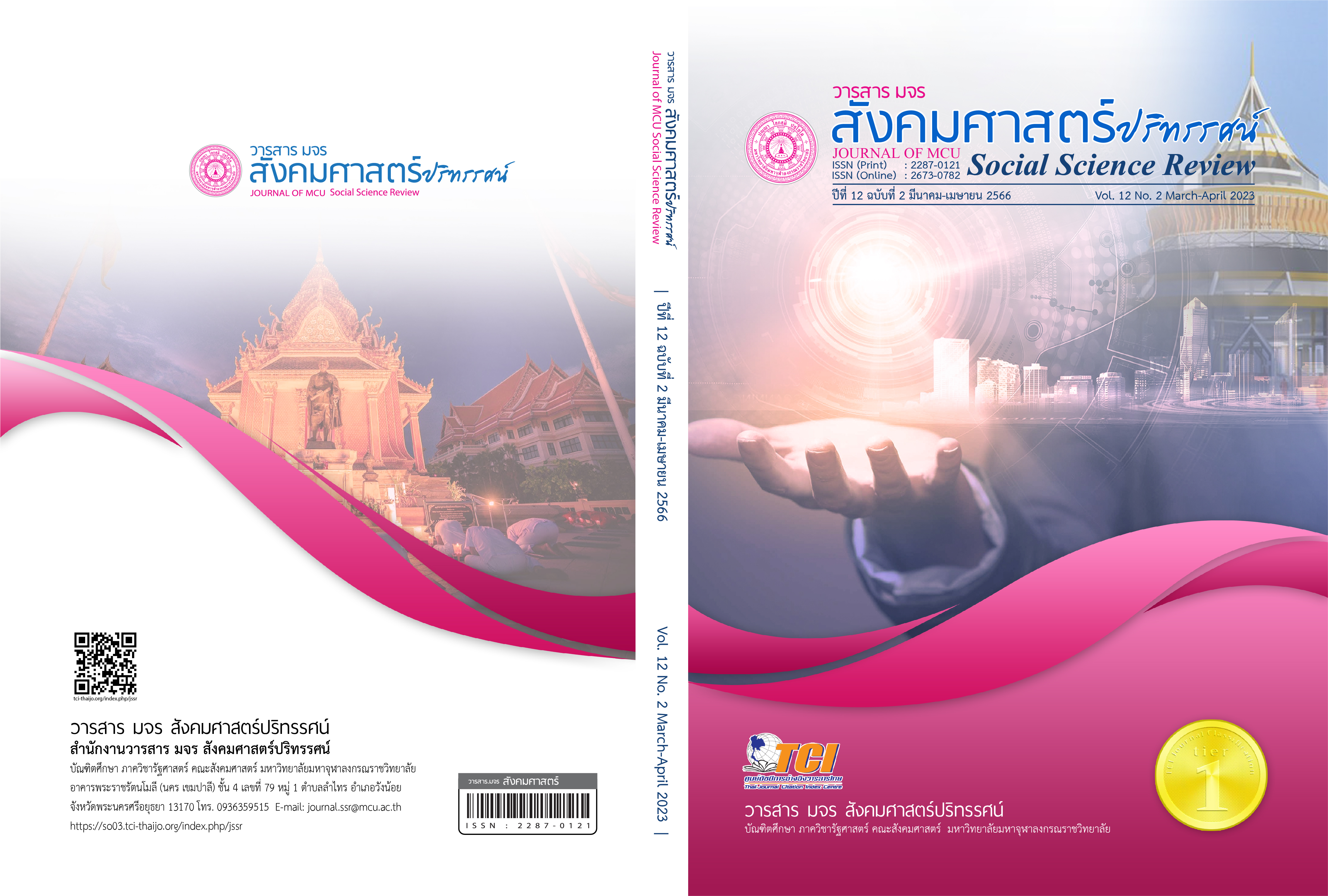การจัดการทรัพยากรมนุษย์เพื่อสร้างความผูกพันต่อองค์กรของธุรกิจหลักทรัพย์
คำสำคัญ:
การจัดการทรัพยากรมนุษย์, ความผูกพันต่อองค์กร, ธุรกิจหลักทรัพย์บทคัดย่อ
การวิจัยนี้มีวัตถุประสงค์เพื่อศึกษาสภาพการจัดการทรัพยากรมนุษย์เพื่อสร้างความผูกพันต่อองค์กรของธุรกิจหลักทรัพย์ ปัจจัยที่ส่งผล และนำเสนอการจัดการทรัพยากรมนุษย์เพื่อสร้างความผูกพันต่อองค์กรของธุรกิจหลักทรัพย์ ระเบียบวิธีวิจัยเป็นแบบผสานวิธี
ผลการวิจัยพบว่า 1. สภาพการจัดการทรัพยากรมนุษย์ โดยภาพรวม อยู่ในระดับมาก 2. ปัจจัยสภาพการจัดการทรัพยากรมนุษย์ ปัจจัยการจัดการทรัพยากรมนุษย์ ปัจจัยหลักหลักสังคหวัตถุ 4 ส่งผลต่อการจัดการทรัพยากรมนุษย์เพื่อสร้างความผูกพันต่อองค์กรของธุรกิจหลักทรัพย์ ทุกด้าน อย่างมีนัยสำคัญที่ระดับ 0.01 ปัจจัยสภาพการจัดการทรัพยากรมนุษย์ สามารถอธิบายความผันแปรได้ร้อยละ 67.7 ปัจจัยการจัดการทรัพยากรมนุษย์ทำนายได้ร้อยละ 69.8 ปัจจัยหลักหลักสังคหวัตถุ 4 ทำนายได้ร้อยละ 73.3 3. การจัดการทรัพยากรมนุษย์เพื่อสร้างความผูกพันต่อองค์กรของธุรกิจหลักทรัพย์ 3.1 ความผูกพันด้านจิตใจ ประกอบด้วย บุคลากรรักและหวงแหนองค์กร มีความผูกพันต่อองค์กร บุคลากรยินดีที่ได้เป็นสมาชิกขององค์กร 3.2 ความผูกพันด้านการคงอยู่ ประกอบด้วย การคงอยู่ของบุคลากรคงที่ บุคลากรไม่คิดลาออกจากงาน บุคลากรยินดีที่จะอยู่เพื่อทำประโยชน์ต่อองค์กร และ 3.3 ความผูกพันด้านบรรทัดฐาน ประกอบด้วย บุคลากรรักในเกียรติและศักดิ์ศรีของตนและองค์กร ปฏิบัติตามหลักจริยธรรมองค์กรอย่างเคร่งครัด ร่วมกันรักษาภาพพจน์ที่ดีขององค์กร
เอกสารอ้างอิง
กมลาศ ภูวชนาธิพงศ์. (2562). การเสริมสร้างจิตสำนึกด้านคุณธรรมตามหลักพุทธจิตวิทยาสำหรับเยาวชน. วารสารบัณฑิตศึกษาปริทรรศน์, 15(ฉบับเพิ่มเติม), 75-88.
ฒนสรณ์ เกียรติฐิติคุณ. (2557). รูปแบบการบูรณาการหลักพุทธธรรมในการพัฒนาประสิทธิภาพการปฏิบัติงานของเจ้าหน้าที่เทศกิจ กรุงเทพมหานคร (วิทยานิพนธ์พุทธศาสตรดุษฎีบัณฑิต สาขารัฐประศาสนศาสตร์). พระนครศรีอยุธยา: มหาวิทยาลัยมหาจุฬาลงกรณราชวิทยาลัย.
ดลนพร วราโพธิ์. 2560. การจัดการทรัพยากรมนุษย์ของมหาวิทยาลัยสงฆ์เพื่อรองรับการเข้าสู่ประชาคมอาเซียน (ดุษฎีนิพนธ์พุทธศาสตรดุษฎีบัณฑิต สาขาวิชารัฐประศาสนศาสตร์). พระนครศรีอยุธยา: มหาวิทยาลัยมหาจุฬาลงกรณราชวิทยาลัย.
ธงชัย สันติวงษ์. (2554). พฤติกรรมบุคคลในองค์การ (พิมพ์ครั้งที่ 5). กรุงเทพฯ: เจริญพัฒน์.
ธิติวุฒิ หมั่นมี. (2556). การสร้างความผูกพันต่อองค์กรของพนักงานองค์กรปกครองส่วนท้องถิ่นในภาคตะวันออกเฉียงเหนือ (ดุษฎีนิพนธ์ ปรัชญาดุษฎีบัณฑิต สาขารัฐประศาสนศาสตร์). พระนครศรีอยุธยา: มหาวิทยาลัยมหาจุฬาลงกรณราชวิทยาลัย.
ธีรชัย ชุติมันต์. (2559). รูปแบบการจัดการชุมชนตามแนววิถีพุทธที่มีผลต่อการพัฒนาท้องถิ่นขององค์กรปกครองส่วนท้องถิ่น (ดุษฎีนิพนธ์พุทธศาสตรดุษฎีบัณฑิต สาขาวิชารัฐประศาสนศาสตร์). พระนครศรีอยุธยา: มหาวิทยาลัยมหาจุฬาลงกรณราชวิทยาลัย.
นพ ศรีบุญนาค. (2546). ศาสตร์การจัดการ. กรุงเทพฯ: สูตรไพศาล.
ปชาบดี แย้มสุนทร. (2557). กลยุทธ์การส่งเสริมความผูกพันต่อองค์กรตามหลักสังคหธรรมของแรงงานอุตสาหกรรมอิเล็กทรอนิคส์. (ดุษฎีนิพนธ์ ปรัชญาดุษฎีบัณฑิต สาขารัฐประศาสนศาสตร์). พระนครศรีอยุธยา: มหาวิทยาลัยมหาจุฬาลงกรณราชวิทยาลัย.
พระครูกิตติพลาธร (กัด กิตฺติธโร). (2562). รูปแบบการพัฒนาชีวิตด้วยหลักสังคหวัตถุ 4 ของกลุ่มชาติพันธุ์ ใน จังหวัดศรีสะเกษ (พุทธศาสตรดุษฎีบัณฑิต สาขาพระพุทธศาสนา). พระนครศรีอยุธยา: มหาวิทยาลัยมหาจุฬาลงกรณราชวิทยาลัย.
พระครูสุนทรวัชรกิจ (บุญธรรม ธมฺมิโก). (2557). กลยุทธ์การจัดการทรัพยากรมนุษย์ของคณะสงฆ์จังหวัดเพชรบุรี (วิทยานิพนธ์พุทธศาสตรดุษฎีบัณฑิต สาขาวิชาการจัดการเชิงพุทธ). พระนครศรีอยุธยา: มหาวิทยาลัยมหาจุฬาลงกรณราชวิทยาลัย.
พระมหาวินัย สิริภทฺโท (แช่มสายทอง). (2561). การบูรณาการหลักมนุษยสัมพันธ์กับหลักสังคหวัตถุ 4 ของผู้บริหารโรงเรียน (ดุษฎีนิพนธ์พุทธศาสตรดุษฎีบัณฑิต สาขาวิชาการบริหารการศึกษา). พระนครศรีอยุธยา: มหาวิทยาลัยมหาจุฬาลงกรณราชวิทยาลัย.
พระมหาศุภกิจ สุภกิจฺโจ (ภักดีแสน). (2557). กลยุทธ์การพัฒนาทรัพยากรมนุษย์ของสำนักงานส่งเสริมการศึกษานอกระบบและการศึกษาตามอัธยาศัย กรุงเทพมหานคร (วิทยานิพนธ์พุทธศาสตรดุษฎีบัณฑิต สาขาวิชารัฐประศาสนศาสตร์). พระนครศรีอยุธยา: มหาวิทยาลัยมหาจุฬาลงกรณราชวิทยาลัย.
มัทนา วังถนอมศักดิ์. (2550). ปัจจัยที่มีผลต่อความผูกพันของบุคลากรในมหาวิทยาลัยเอกชน (วิทยานิพนธ์ปรัชญาดุษฎีบัณฑิต สาขาวิชาการบริหารการศึกษา). พระนครศรีอยุธยา: มหาวิทยาลัยศิลปากร.
มานิตย์ มัลลวงศ์ และคณะ. (2548). ความผูกพันต่อองค์การของผู้ปฏิบัติงานในมหาวิทยาลัยเทคโนโลยีราชมงคลล้านนาวิทยาเขตภาคพายัพ (รายงานการวิจัย). เชียงใหม่: มหาวิทยาลัยเทคโนโลยีราชมงคลล้านนา.
วิชญาภา เมธีวรฉัตร. (2557).รูปแบบการพัฒนาทรัพยากรมนุษย์เชิงพุทธของมหาวิทยาลัยราชภัฏภาคเหนือตอนล่าง 2 (วิทยานิพนธ์พุทธศาสตรดุษฎีบัณฑิต สาขาวิชารัฐประศาสนศาสตร์). พระนครศรีอยุธยา: มหาวิทยาลัยมหาจุฬาลงกรณราชวิทยาลัย.
สุนทร สุวรรณพร. (2557). การจัดการทรัพยากรมนุษย์ตามหลักธรรมาภิบาลขององค์กรปกครองส่วนท้องถิ่นไทย (วิทยานิพนธ์พุทธศาสตรดุษฎีบัณฑิต สาขาวิชารัฐประศาสนศาสตร์). พระนครศรีอยุธยา: มหาวิทยาลัยมหาจุฬาลงกรณราชวิทยาลัย.
สุวรีย์ สิริโภคาภิรมณ์. (2546). การวิจัยทางการศึกษา. ลพบุรี: ฝ่ายเอกสารการพิมพ์สถาบันราชภัฏเทพสตรี.
Bolon, D. S. (1997). Organizational Citizenship Behavior among Hospital Employee: AMultidimensional Analysis involving Job Satisfaction and Organizational Commitment. Hospital & Health Services Administration, 42 (2), 221–242.
Corporate Leadership Council. (2006). Driving Performance and Retention through Employee Engagement (Research Report). Washington. DC: The Corporate Executive Board Company (UK) Ltd.
Kadcher yschuk.R. (1998). Teacher Commitment: A Study of the Organizational Commitment. Professional Commitment. Dissertation Abstracts International. Union Commitment of Teachers in Public School in Saskatchewan.
ดาวน์โหลด
เผยแพร่แล้ว
รูปแบบการอ้างอิง
ฉบับ
ประเภทบทความ
สัญญาอนุญาต
ลิขสิทธิ์ (c) 2023 วารสาร มจร สังคมศาสตร์ปริทรรศน์

อนุญาตภายใต้เงื่อนไข Creative Commons Attribution-NonCommercial-NoDerivatives 4.0 International License.
เพื่อให้เป็นไปตามกฎหมายลิขสิทธิ์ ผู้นิพนธ์ทุกท่านต้องลงลายมือชื่อในแบบฟอร์มใบมอบลิขสิทธิ์บทความให้แก่วารสารฯ พร้อมกับบทความต้นฉบับที่ได้แก้ไขครั้งสุดท้าย นอกจากนี้ ผู้นิพนธ์ทุกท่านต้องยืนยันว่าบทความต้นฉบับที่ส่งมาตีพิมพ์นั้น ได้ส่งมาตีพิมพ์เฉพาะในวารสาร มจร สังคมศาสตร์ปริทรรศน์ เพียงแห่งเดียวเท่านั้น หากมีการใช้ภาพหรือตารางหรือเนื้อหาอื่นๆ ของผู้นิพนธ์อื่นที่ปรากฏในสิ่งตีพิมพ์อื่นมาแล้ว ผู้นิพนธ์ต้องขออนุญาตเจ้าของลิขสิทธิ์ก่อน พร้อมทั้งแสดงหนังสือที่ได้รับการยินยอมต่อบรรณาธิการ ก่อนที่บทความจะได้รับการตีพิมพ์ หากไม่เป็นไปตามข้อกำหนดเบื้องต้น ทางวารสารจะถอดบทความของท่านออกโดยไม่มีข้อยกเว้นใดๆ ทั้งสิ้น





